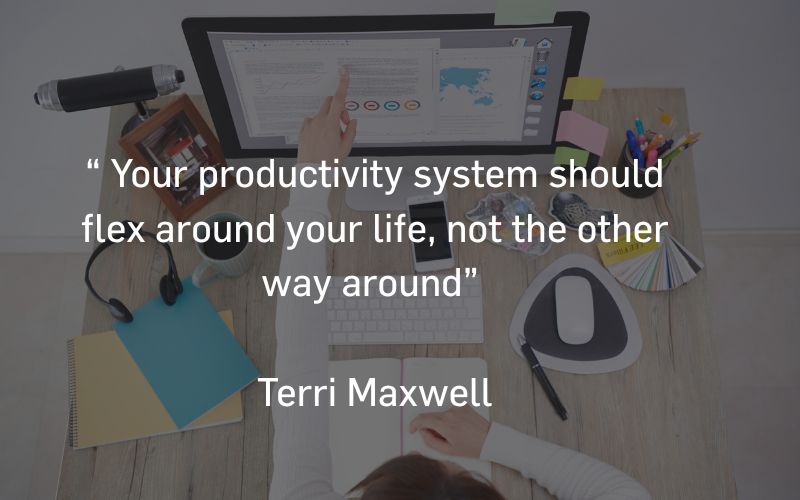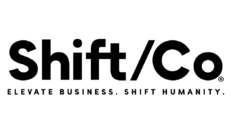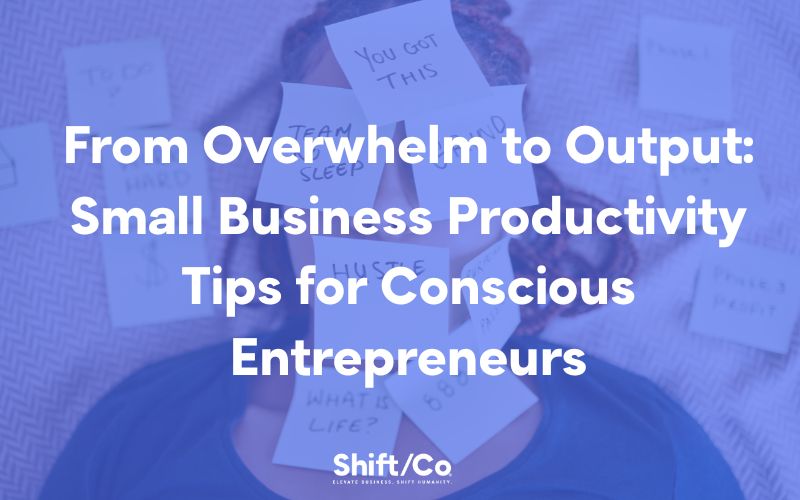Optimizing small business productivity in a conscious enterprise often feels like running a marathon through quicksand. Endless to-do lists, competing priorities, and the pressure to make your mission matter can leave even the most passionate founders overwhelmed. But what if you could turn that complexity into clarity and make focus your superpower?
In this blog, you’ll discover the actionable techniques to improve your focus, habits, and mindset to supercharge your small business productivity, while staying true to your purpose. We’ll cover:
- Why maintaining focus feels impossible for conscious entrepreneurs
- The three pillars of founder focus
- The Business Simple™ method for small business productivity
- How to invest (not just spend) your time
- Energy × Impact Mapping & habit stacking
- Conquering FUD (Fear, Uncertainty, Doubt)
- The Athlete’s Advantage: Intentional effort for productivity
Let’s dive in.
Why Focus Feels Impossible for Conscious Entrepreneurs
“When you pour your heart into a business, every task feels urgent—and every distraction feels like a threat,” explains Terri Maxwell, CEO of Shift/Co. “Conscious entrepreneurs juggle mission, marketing, and money, and it can feel like you’re steering five ships at once.”
From Corporate Structure to Small Business Freedom
In the corporate world, Monday mornings came with a baked‑in schedule: 9–5 meetings, quarterly targets, and clear KPIs. As a small business founder, that structure vanishes. You set your own hours, define your own goals, and suddenly every decision—what to work on first, whom to hire, which software to buy—lands on your shoulders.
Hypothetical Example: Sarah, a wellness coach, used to follow her studio’s class schedule. After launching her own practice, she found herself bouncing between client calls, content creation, and bookkeeping—often working late into the night just to keep up.
The Overwhelm of Mission-Driven Conscious Entrepreneurs
Conscious entrepreneurs aren’t just in business to make money—they’re in business to solve real problems. That deep “why” adds meaning, but it also amplifies every choice. Pricing your offers might bring about a wave of second-guessing.
“Your to-do list may have 100 items,” says Terri. “But your vision has 1,000. The gap between daily reality and long-term mission is what paralyzes many founders.”
The Three Pillars of Founder Focus for Small Business Productivity
To regain control, start by strengthening these foundational elements:
- Clarity on Core Priorities
- Personal Productivity Styles
- Accountability Mechanisms
Clarity on Core Priorities
Without a clear north star, every shiny object looks like the next big thing you should try. You need a framework to decide what truly deserves your time.
To sharpen your focus:
- Define Your Ultimate Impact Goal. Start by articulating the one change you want your business to bring about in the world. Maybe you’re a sustainable fashion brand whose true north is reducing landfill waste by 50% over five years. That impact goal becomes the lens through which you evaluate every project.
- Break It Down into Quarterly “Levers.” Once your long-term vision is set, identify 2–3 strategic levers to pull each quarter. Those might be “increase repeat purchase rate by 20%” or “forge two new retail partnerships.” Each lever should directly improve your ultimate impact.
- Use a Prioritization Matrix. Plot each potential project or task against two axes—“strategic impact” and “effort required.” High-impact, low-effort items (like sending a targeted e‑mail to your top 100 customers) become immediate actions; low-impact, high-effort tasks (redesigning your entire website) get paused or delegated.
“When you know exactly where you’re headed, saying ‘no’ becomes as powerful as saying ‘yes,’” Terri Maxwell reminds us.
Personal Productivity Styles to Maximize Small Business Productivity
Not all tools work for everyone. Some founders thrive on time‑blocking; others prefer Pomodoro sprints or task batching. Discover what aligns with your natural rhythm.
- Experiment with Time‑Blocking. Schedule themed blocks on your calendar—“Creative Content” 9–11 am, “Client Outreach” 1–2 pm, “Admin” 3–4 pm. This minimizes context‑switching and trains your brain to dive deep.
- Try Pomodoro Sprints. If you’re someone who loves ticking off short, intense sessions, set a timer for 25 minutes of laser focus, then take a 5-minute break. Four sprints equal one productivity cycle—perfect for tackling writing, research, or brainstorming.
- Batch Similar Tasks. Group like‑with‑like: answer all your e‑mails in one go, record multiple videos back‑to‑back, or batch all your social media scheduling on a single afternoon. This reduces the cognitive load of flipping between different mindsets.
- Honor Your Peak Energy Times. Are you most creative at dawn? Reserve that time for strategy and brainstorming. Do you hit an afternoon slump? Use that window for lower‑engagement tasks like invoicing or bookkeeping.
“Your productivity system should flex around your life, not the other way around,” says Terri. “When you align your natural rhythms with your work, you access exponential gains in both output and well-being.”

Accountability Mechanisms
Self-discipline is powerful, but even the most motivated entrepreneurs can hit a wall. Built-in accountability structures keep you moving forward:
- Peer Masterminds. Join a small cohort of fellow conscious entrepreneurs who meet weekly to share goals, report on progress, and brainstorm solutions. The simple act of knowing you’ll present your progress creates a powerful incentive to follow through.
- Public Commitment Devices. Use social channels or your newsletter to announce a launch date or revenue target. Once it’s out in the world, your reputation and sense of integrity work as built-in motivators.
- One-on-One Coaching. A coach or mentor provides tailored feedback, challenges your assumptions, and holds you to your highest standards. “Accountability turns ideas into action,” Terri reminds us—but often you need that external mirror to see blind spots.
- Automated Check‑Ins. Simple tools like weekly calendar reminders or Slack bots can prompt you to log your daily “dos” or weekly KPIs. Over time, these small nudges build a habit of consistency.
“The best ideas flop without execution,” Terri says. “Accountability isn’t about policing—it’s about partnership in your mission.”
Each of these pillars—clarity, personalized productivity, and accountability—forms the foundation for sustainable, small business productivity and keeps conscious entrepreneurs on track to double their businesses and triple their impact.
Business Simple™: A Roadmap to Small Business Productivity
Shift/Co’s signature Business Simple™ method transforms entrepreneurial overwhelm into a clear, purposeful pathway.
Supply vs. Demand for Conscious Entrepreneurs
Ask yourself: Is your focus on creating new offers (supply) or filling existing programs (demand)? For a vegan soap maker, supply might mean formulating three new scents; demand means onboarding five repeat‑purchase customers. Balance is key.
“When you double a conscious business, you triple its impact,” Terri often says. “But first, you must know whether to build or to sell.”
Annual Goals as Your Small Business Productivity Compass
Define one bold, mission-aligned goal for the year—e.g., “Serve 1,000 coaching clients with our resilience program.” Break it into 2–3 capabilities to master this quarter: marketing funnels, group facilitation skills, and client retention systems.
Weekly Priorities & Daily Dues
Pick a single weekly priority: perhaps launching your webinar. Then commit to 1–2 daily “dos,” non-negotiable actions that advance that priority, like writing one slide deck section or recording a five-minute promo video.
Hypothetical Example: Jake, who runs an eco‑tourism consultancy, sets Monday to outline blog content, Tuesday to optimize SEO, and Wednesday to pitch collaborators—ensuring each day moves his core priority forward.
Investing, Not Spending, Your Time
Time for a paradigm shift: treat each hour like a stack of dollars you can invest or waste.
Calculate Your Productivity ROI
Decide your target annual revenue—say $100,000—and divide by 2,000 working hours. That gives a $50/hour benchmark. Now, when you face a task:
- Do it if it generates more than $50/hr in value.
- Delegate it if someone else can do it for less—and it frees you for higher‑value work.
- Drop it if it doesn’t move the needle in your business at all.
“Your time is the most finite resource you have,” Terri emphasizes. “Treat it like gold—because it is.”
Small Investments for Big Gains
Sometimes investing in yourself pays off more than cutting corners. Booking a 30-minute power nap or a massage might seem indulgent, but the boost in clarity can lead to breakthrough ideas that earn you hundreds of dollars more.
Energy × Impact Mapping & Habit Stacking
Pair how much energy a task takes with the impact it delivers to decide what to tackle first.
The Small Business Productivity Energy‑Impact Grid


Habit‑Stacking for Peak Productivity
Link a “must‑do” with a passion project. For example, record your podcast (high impact) immediately after your morning run. The endorphin boost primes your brain for creative work—and you get two birds with one stone.
Conquering FUD to Supercharge Productivity
Fear, Uncertainty, Doubt (FUD) lurk behind missed deadlines and stalled launches. Here’s how to break free.
“The only way out of FUD is through tiny, consistent steps,” Terri advises. “Show up for one small win each day, and you’ll build unstoppable momentum.”
The Athlete’s Advantage: Intentional Effort for Productivity
Ex‑athletes often excel as entrepreneurs because they grasp the difference between being in “motion” (busywork) and making “moves” (targeted effort).
Motion vs. Moves
- Motion: scattered tasks that feel productive but rarely shift outcomes
- Moves: deliberate actions designed to hit your key performance indicators
Daily Journal Prompt:
“Will this action move my business forward? If yes, do it. If no, delegate or drop it.”
Conclusion & Next Steps
You now have a Small Business Productivity playbook designed for conscious entrepreneurs:
- Clarify your core priorities with the Business Simple™ roadmap
- Invest your time with an ROI mindset
- Map tasks by energy and impact, then habit‑stack
- Defeat FUD through micro‑wins
- Apply the Athlete’s Advantage for intentional progress
Your challenge this week:
- Calculate your $/hour benchmark.
- Define one weekly priority & two daily dos.
- Share one micro‑win in our Shift/Co member group.
Need support mastering these habits? Join our next Founder Focus workshop or hop into the Shift/Co community today. Your mission—and your productivity—await.
These principles were developed by Terri Maxwell, CEO of Shift/Co, drawing from over two decades of business growth and leadership experience.
Read also:
The Difference Maker’s Playbook: How Conscious Entrepreneurs Can Grow Their Business and Impact
Thriving in Uncertainty: A Conscious Entrepreneur’s Guide

Shift/Co is a place where Founders gather to grow.
Shift/Co is a global community dedicated to conscious business growth. We empower entrepreneurs to grow their businesses through innovative tools, expert coaching and mentoring, and a supportive network. Our comprehensive approach includes personalized training, leadership development, and a collaborative environment, ensuring that members can achieve significant business growth while positively impacting the world. Join Shift/Co to elevate your business and be part of a movement that believes in doing good business better.

